1lumen selects and reviews products personally. We may earn affiliate commissions through our links, which help support our testing.
Cyansky P50R review
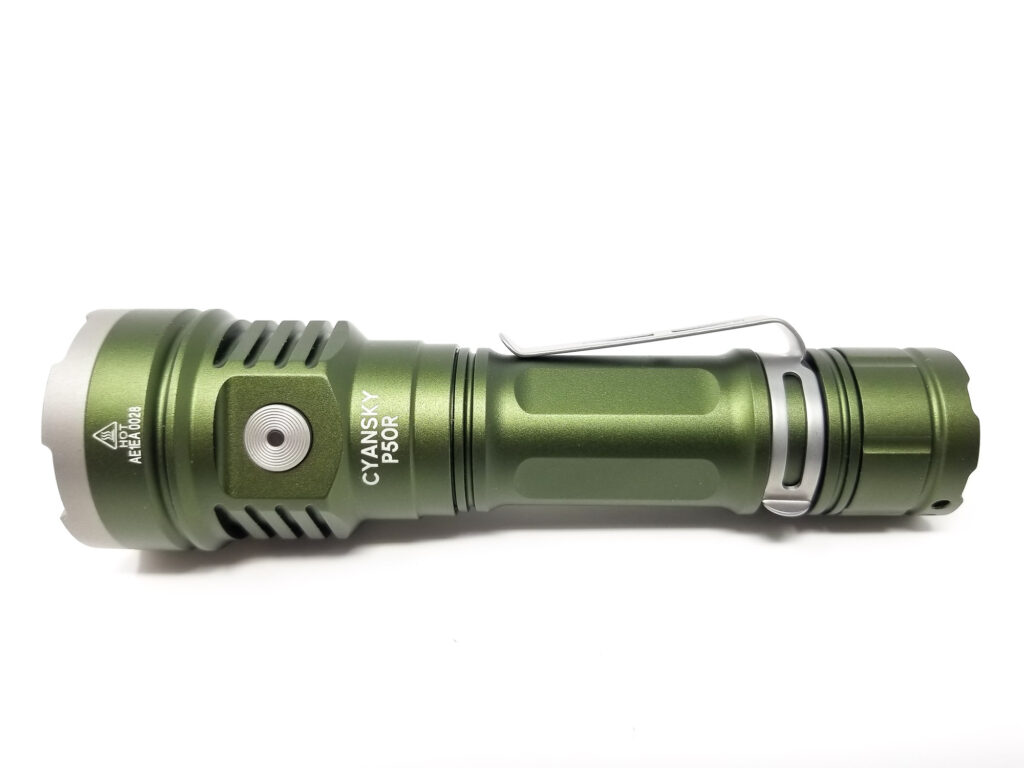
Cyansky P50R specs
| Brand & Model | Cyansky P50R |
|---|---|
| Flashlight category | High output, general purpose |
| LED | 4*Cree XHP50.3 HI |
| Max. output | 12,000 lumens |
| Max. beam distance | 328 meters |
| Max. beam intensity | 26,896 cd |
| Battery config. | 1*21700 |
| Onboard charging | USB type C |
| Main modes | 5 |
| Blinkies | Strobe |
| Waterproof | IP68 |
| Review publication date | October 2023 |
Review intro:
UPDATE. After the review was published, Cyansky sent out an updated P50R with some revisions and tweaks to the user interface and some changes to the programming, reportedly to address the issues with performance and refresh the quirky UI. I re-tested the Turbo runtime and added the user interface revisions. There were no other changes to the flashlight’s design or (at least visually) construction. Skip to the User Interface and Performance section for more on the changes to the P50R.
As a start-up company in 2020, Cyansky started small…really small, needing a third party online merchant to peddle their products to the world (remember Freasygears.com?). They’ve grown some over the last two years, and now Cyansky has made a name for themselves in the consumer flashlight market. I’ve reviewed several Cyanskys, and one still gets a great deal of use (the HS6R headlamp).
They’re good lights at a good price with features normally found on more expensive brands like fully regulated drivers, name brand LEDs, and top-notch fit and finish. They were sort of masters of the mid-range flashlight universe; not quite Olight or Acebeam, but better than what you’d get from Astrolux/Mateminco, Wurkkos, or Sofirn. Cyansky never really broke into the higher-output side of things though, including the 10k club (Lumens, that is).
No more!
The new P50R recently released, breaks that trend, and is in my hands and ready for review. Promising 12,000 Lumens it’s purported to be an absolutely legit high output pocket light. It’s sporting quad LEDs, a boost driver, the latest in LED tech, in a single 21700 form factor. I’m super stoked to try this thing out, but let’s see if Cyansky’s claims are true.
Package quality
This is a retail package so it has a hang tag and the presentation is conducive to retail displays. The familiar blue and white colors, feature blurbs, and specs are accounted for here, and it’s basically identical to the first edition. Inside, the light rides in a molded plastic carrier with all the accessories efficiently arranged underneath. Here’s what you get:
- Cyansky P50R
- 2 spare o-rings
- Cyansky BL2140P 4000 mAh 21700 battery
- Lanyard
- USB A to C charging cable
- User manual
- Warranty card
- Holster
This is a proper assortment of accessories, including everything needed to get going. Cyansky included a higher output battery this time, their BL2140P high output 21700. Could this be a moonlighting Samsung 40T? It had a plastic isolator to break the electrical connection, and was sitting at 3.5 volts. I’m glad to see Cyansky included a nicer lanyard this time and a proper holster. Thanks Cyansky.

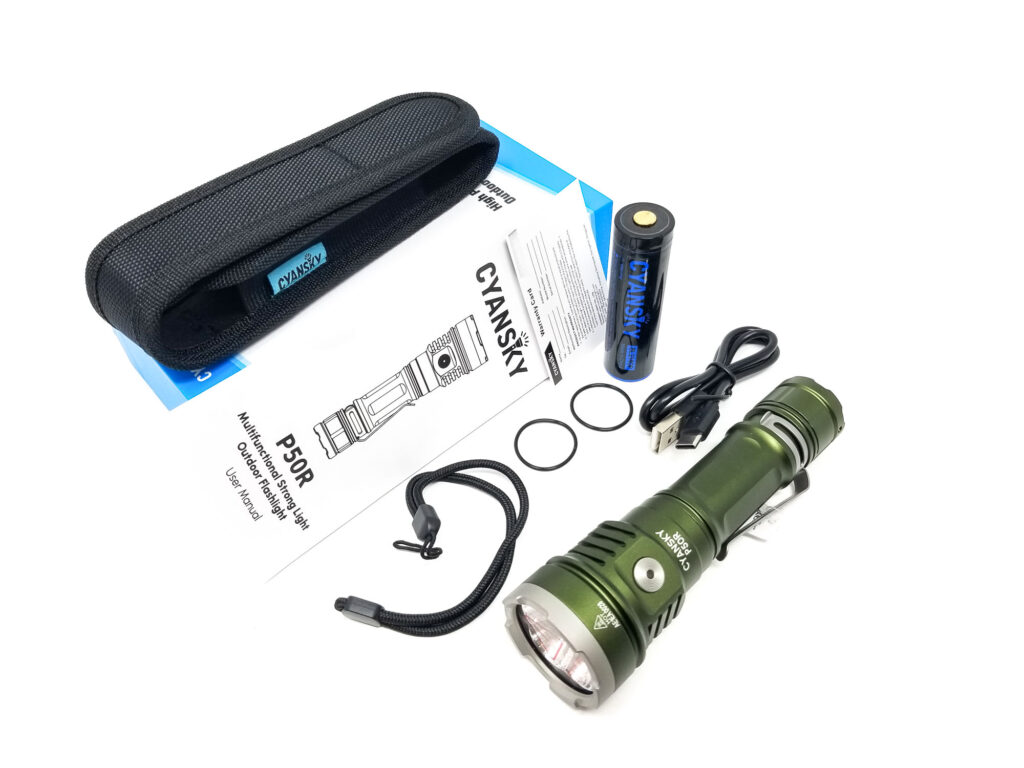
Flashlight in use, Build Quality, and Warranty
The Cyansky P50R is a general purpose flashlight, and while it’s not really a do-all flashlight, the combination of the size, weight, and output range makes is a very versatile bumping-around light for dog (or people) walks, searching for lost things in dark places, or putting a lot of light where there isn’t any. I really liked handling the P50R. It’s a very neutral-handling light that feels smaller than it is. It’s similar in size to a C8 style flashlight like the Acebeam E75, but handles a bit nicer. Despite being heavier up front, it’s pretty balanced.
Despite the absence of knurling, there’s grooves and flats cut into the tube in the right places. The head has some cooling fins, but they aren’t aggressive. The battery tube is one piece and you load the single 21700 from the front a-la Lumintop FW3A. The single direction pocket clip sports a very attractive, premium-looking bead blast finish stainless steel (to match the bezel) and clips to the body. It’s super sturdy, but fairly easy to detach.
There’s two holes in the tailcap for a lanyard, and yes, they’ve very generously sized so you don’t need a toothpick or wood elf size fingers to thread he included lanyard. The included holster is nice and basic with a belt loop and velcro flap closure, and you can orient it any direction you want as long as it’s bezel-up.
The switch seems carried over from the K3 V2. It’s an e-switch with a ribbed metal cover sporting a central LED indicator for on, charge, and battery state. It stands a bit proud and is easy to find by feel. Unlike some other lights with the charge port opposite the switch button, the switch is dissimilar in size, texture, and feel to the point I never found myself haplessly poking at the charge port cover instead of the switch. The action is positive and predictable, but nothing to write home about. Clicking the switch from off will show the battery state (red=bad, green=good). Tail standing is easy thanks to the flat tail.
Cyansky products typically sport excellent built quality, fit and finish at a good price. They’re marketed somewhere in between Thrunite and Acebeam. That said, the P50R is on the pricier side, so much so that it’s the most expensive Cyansky light currently for sale, retailing for about $140.00 US. On paper, it’s in-line with the spec sheet, but it’s a bit steep for what you get though. Read on for more on that.
The light is milled from 6061-T6 aluminum.. The machining is fantastic and it passes the maracas test with flying colors. It’s been given the ‘carry melt’ treatment with all the edges smoothed and knocked down for snag-free carry. There’s no obtuse gaps or wonky part fit-up either, and the finish is flawless. The anodizing is type III HA and comes in black or green. The sample light came in a nice forest green finish (did I mention it’s flawless?).
It’s a semi-matte finish and feels great in the hand; grippy without being brickish. I was sort of expecting to see a spring for the driver like on other high end lights, but not so and it makes do with a brass contact flanked by interference bars, which means button tops only. That’s a bit of a shame on a light like this when Acebeam, Fenix, and others are fielding lights with dual springs and better battery compatibility. There’s a beefy spring in the tail though. The charge port is a silicone rubber deal, and it fits perfectly with a tight seal. The lift tab is flush to the body and I couldn’t get it to lift without intentionally trying to open it.
The bezel is glued and the driver seems pressed and/or glued. In addition, there’s o-rings sealing every joint, and the light is really well sealed up, including the charge port, which is typically a weak link. Even so, Cyansky gives the P50R a IP68 rating for ingress protection, which is great and up there with other higher end flashlights.
Cyansky’s warranty coverage is excellent (from Cyansky): 15 days free replacement: Cyansky Light will offer a new replacement within 15 days of purchase for any manufacturing defects if the problem occurs in normal use. In case the model has been discontinued, the customer will receive a similar or improved model in time. 60 Months free repairs: Cyansky Light will offer free repair within 60 months (5 years) for lights from the date of purchase if problem happens with normal use.
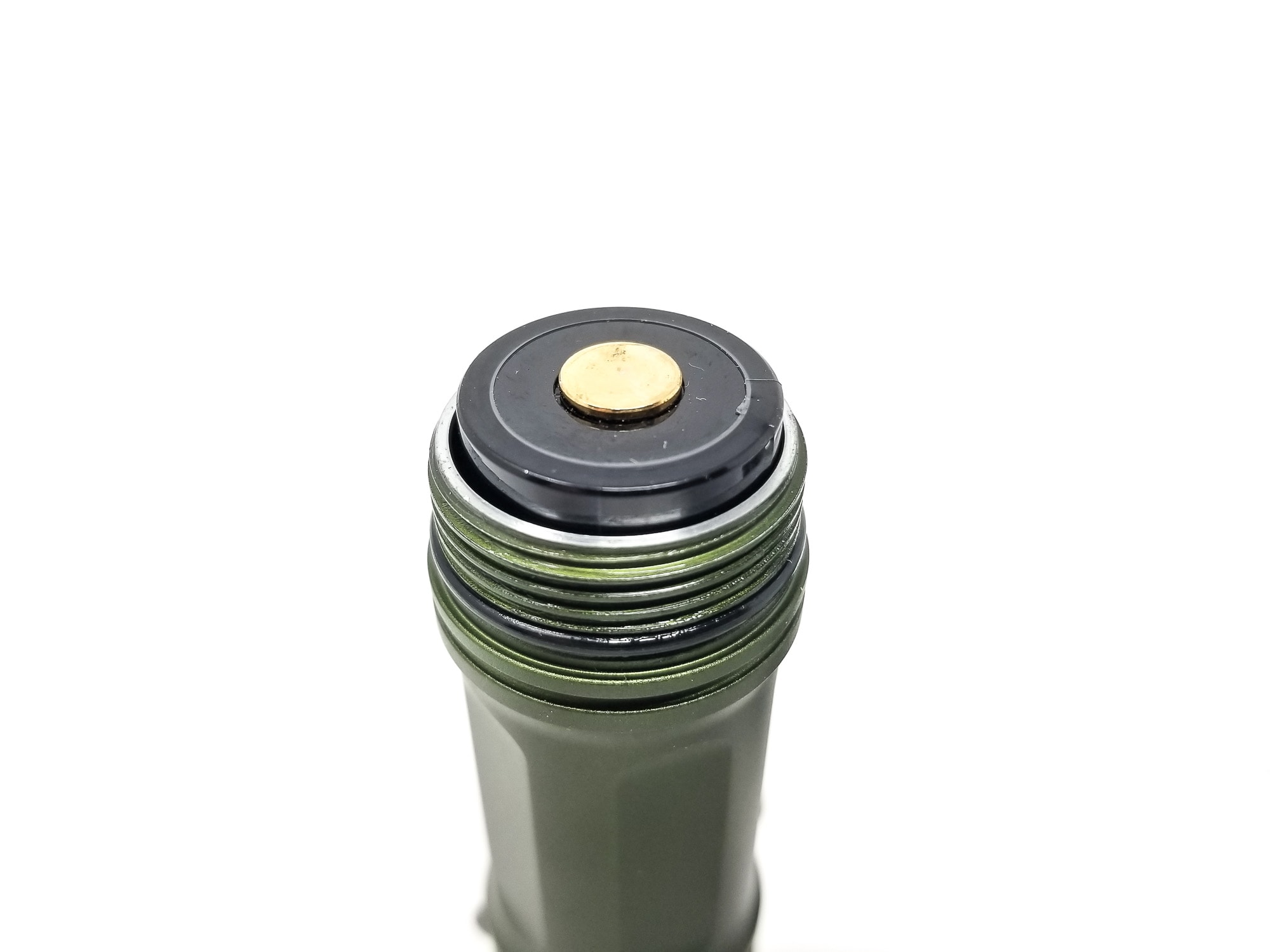
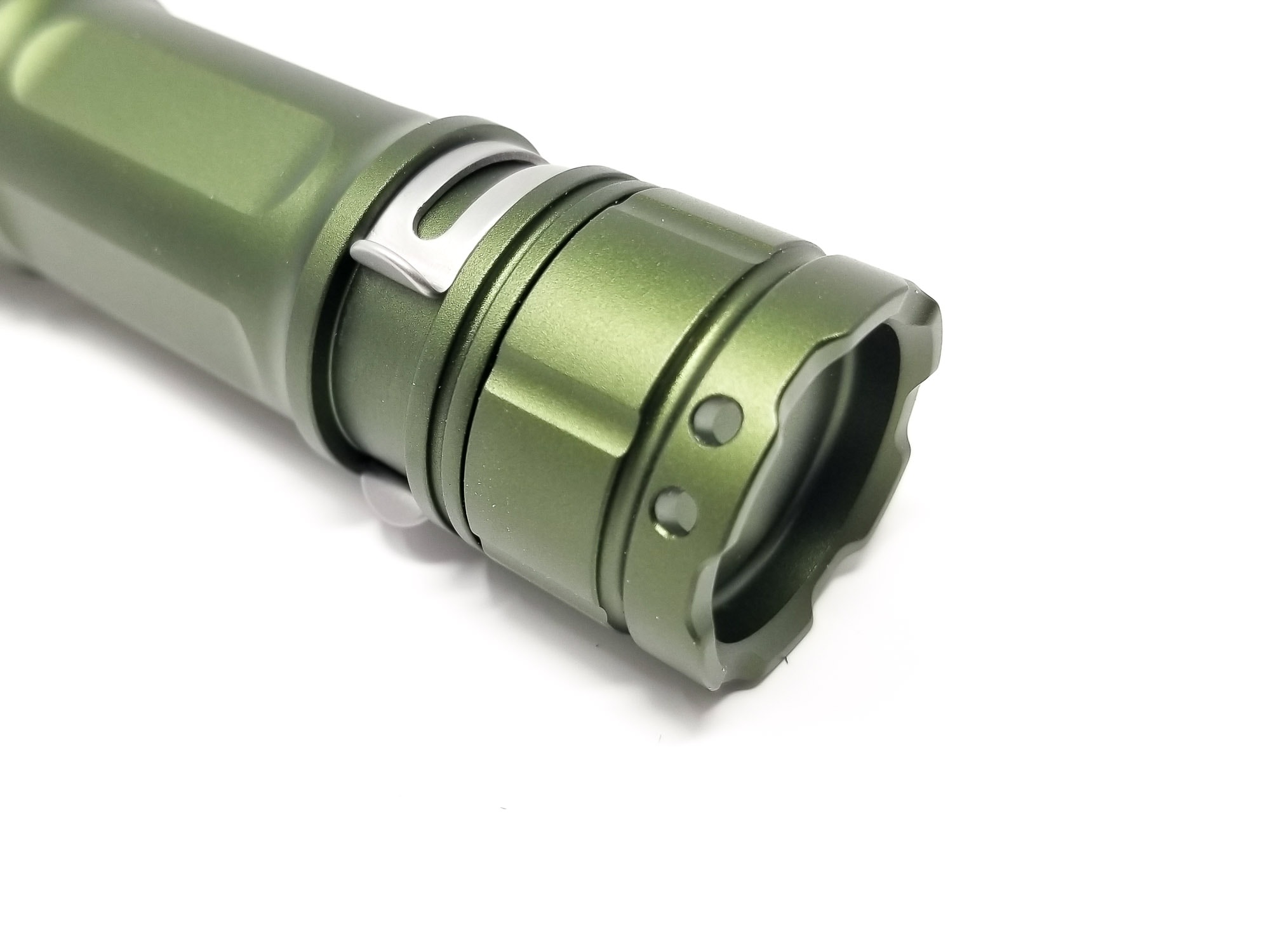
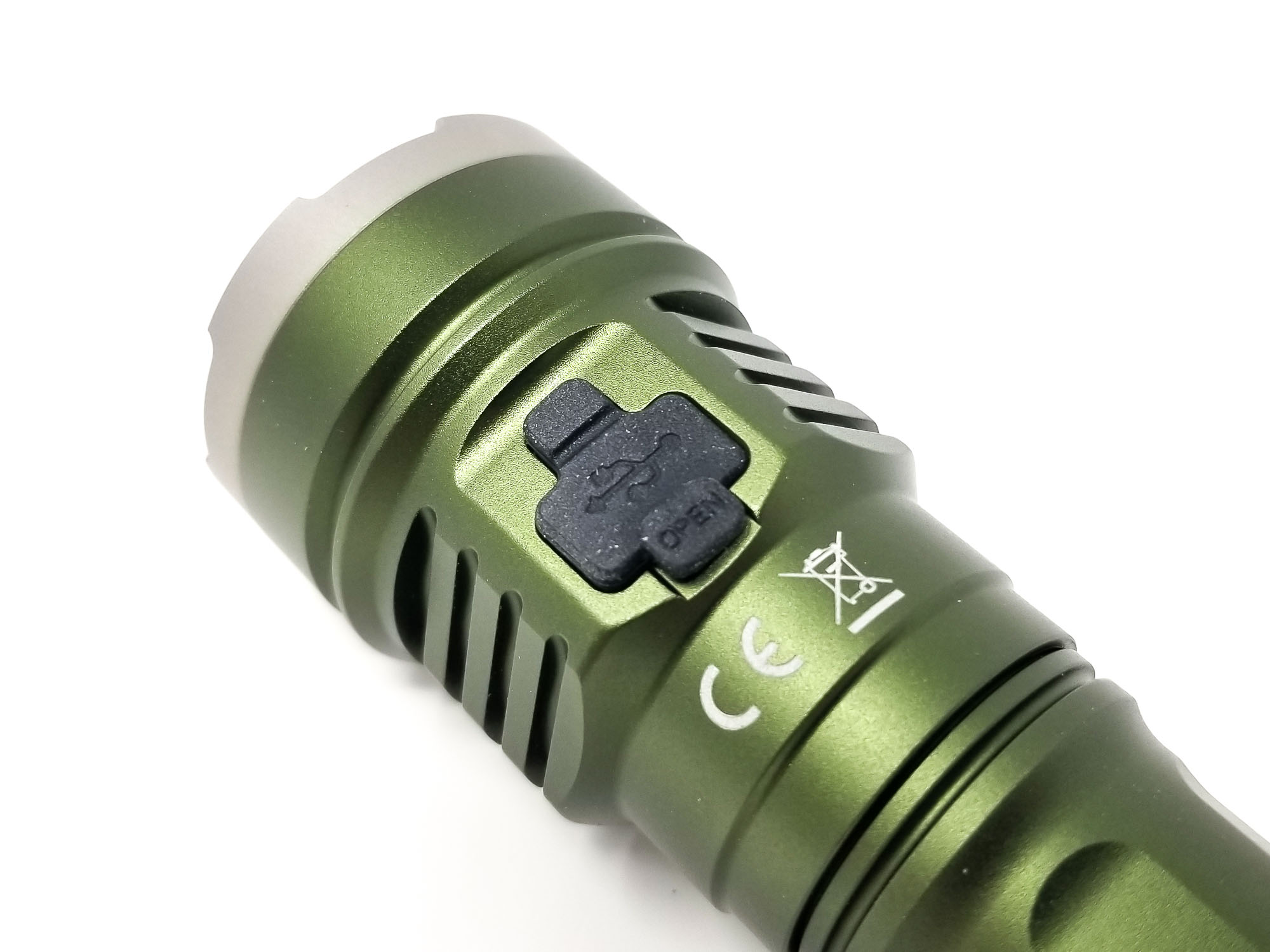


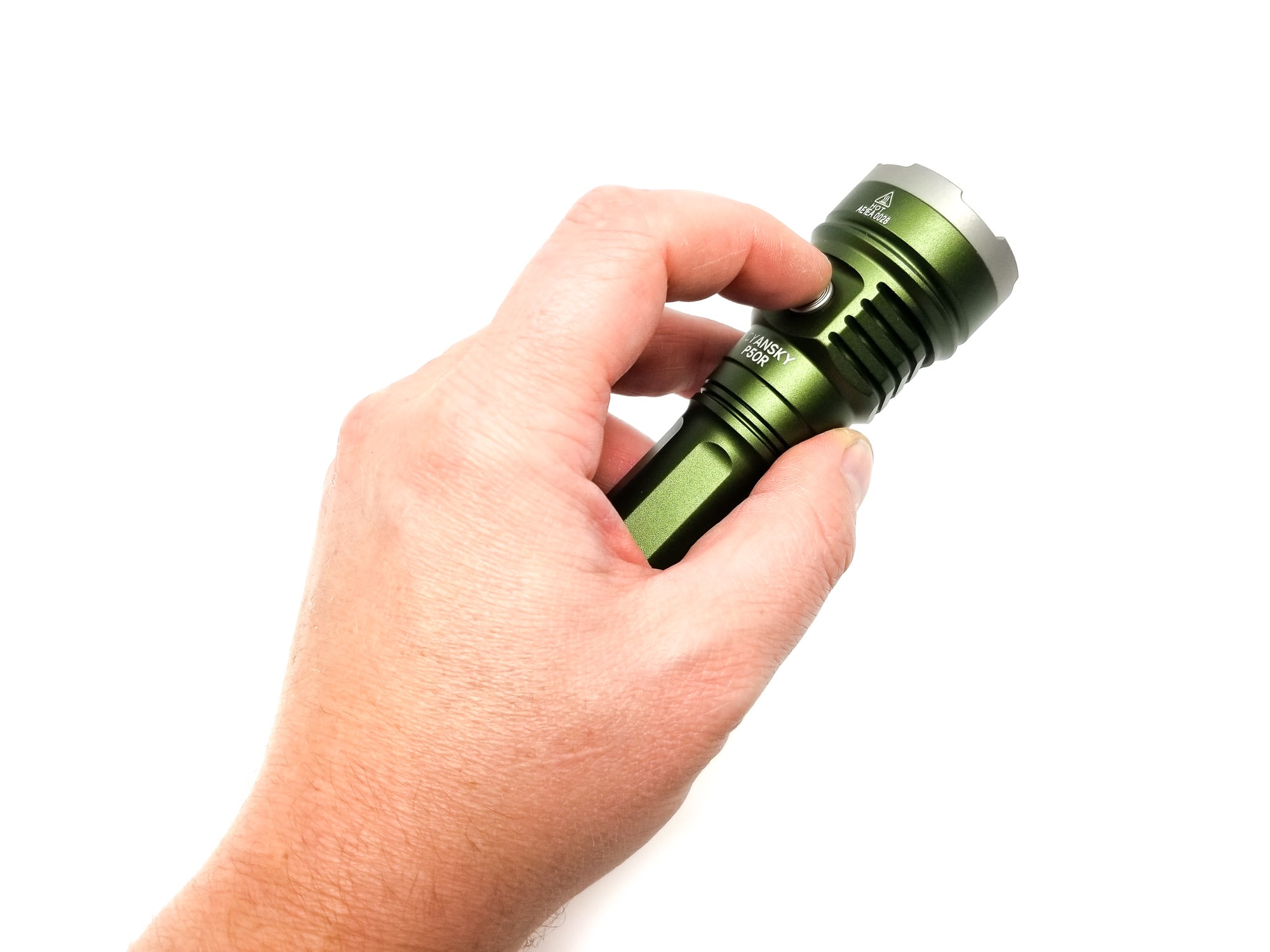
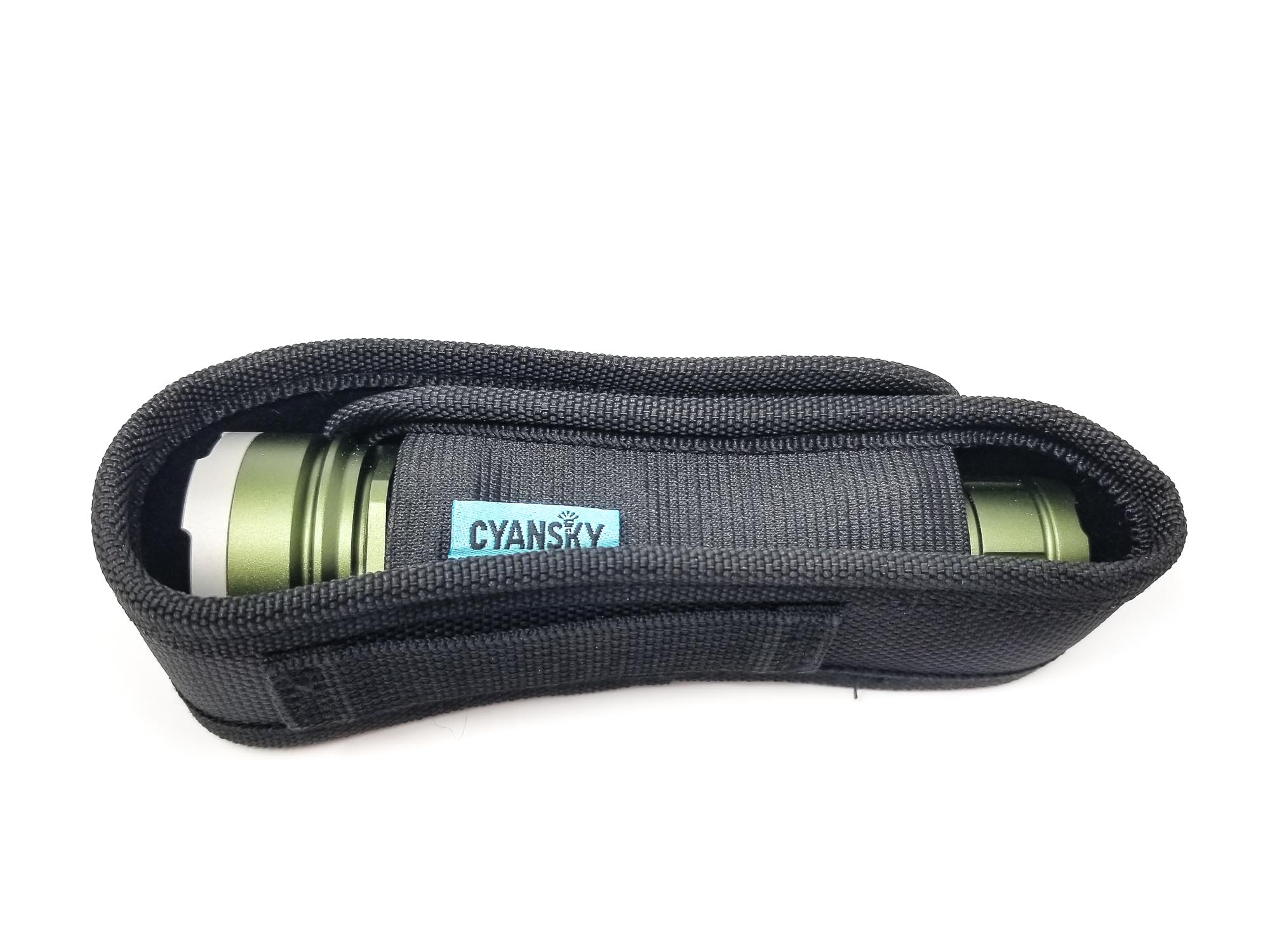

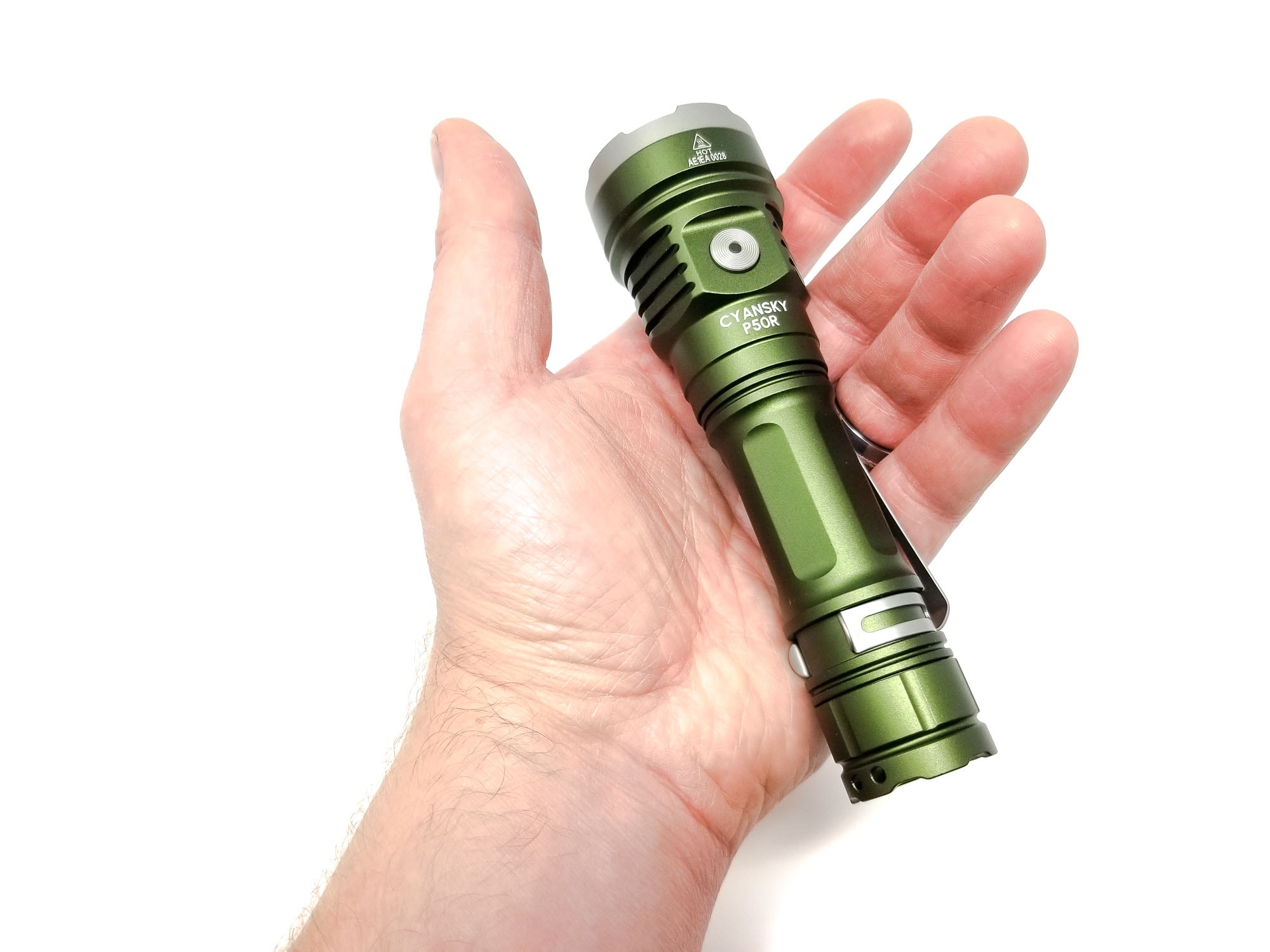
LED, Lens, Bezel, Beam, and Reflector
To get 12,000 Lumens, you need powerful LEDs and the P50R has them in the latest generation of Cree’s 5050 footprint quad die high intensity (domeless) LED, the XHP50.3 HI They can run on 3,6 or 12 volts. This LED performs similarly to the Luminus SST/SFT70 in output and throw with the benefit of being a more modern CSP/flip chip (no exposed bonding wires) design for more robustness and a bit lower thermal resistance at higher drive currents for improved efficiency and output. The test light LEDs are obviously the cool white ones, 6000-6500K and low CRI, which is great for high output.
Being domeless will definitely help with the typically ugly Cree beam since the substrate isn’t completely covered in phosphor, and it does. The P50R has a (flawless) shallow quad SMO reflector topped by a hardened mineral glass (lightly) AR coated lens. The reflector has a small opening at the 6 o’clock position for a light proximity sensor for the auto-dim feature.
The bezel is stainless steel that’s been bead blasted for a matte finish and looks really awesome. It’s also crenulated, and extends a good 5 mm over the lens to protect it from drops or impacts. The beam is great, artifact-free, and features a defined hotspot surrounded by bright spill. It’s a perfect general purpose beam and tuned well to the domeless LEDs with no donut hole. You also get respectable beam distance out of this setup thanks to the domeless LEDs and high output. The Opple Lightmaster Pro has the CCT coming in at 6869K, CRI Ra at 70.5 and the duv at 0.0013.

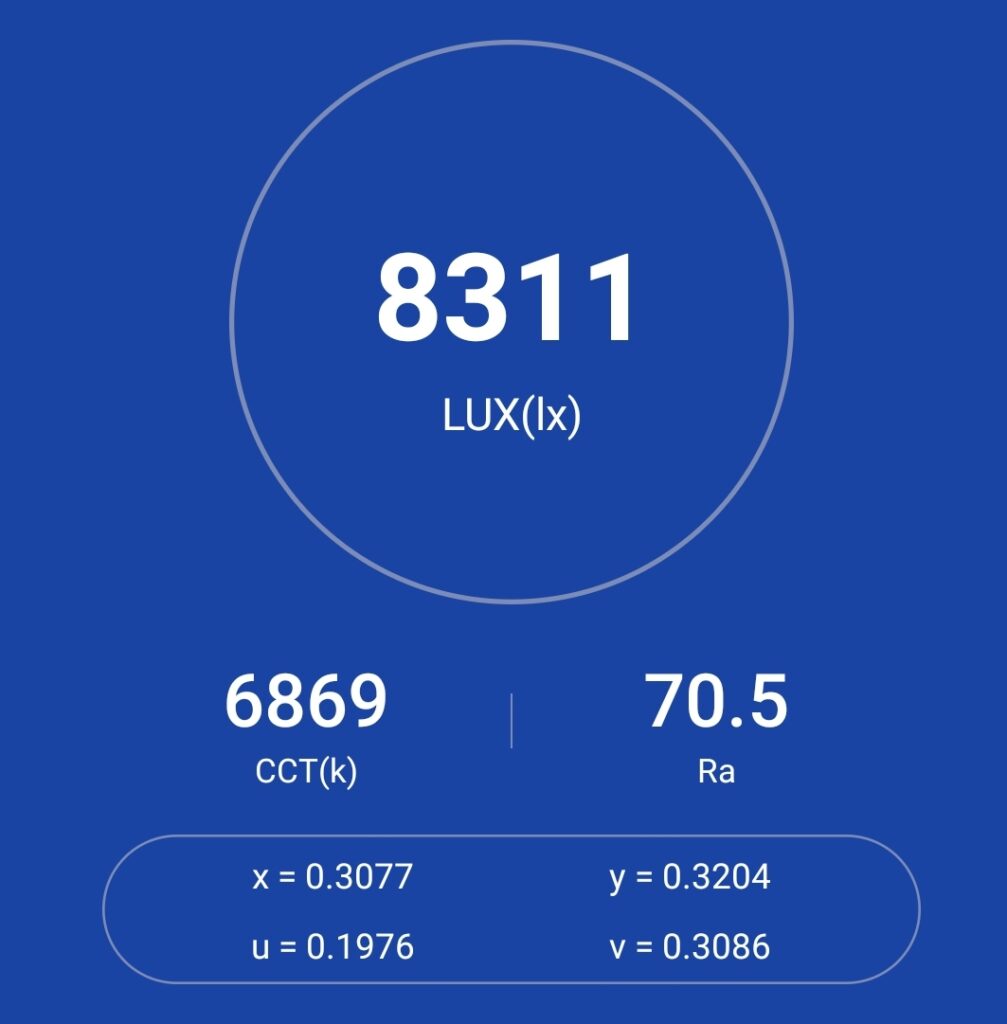
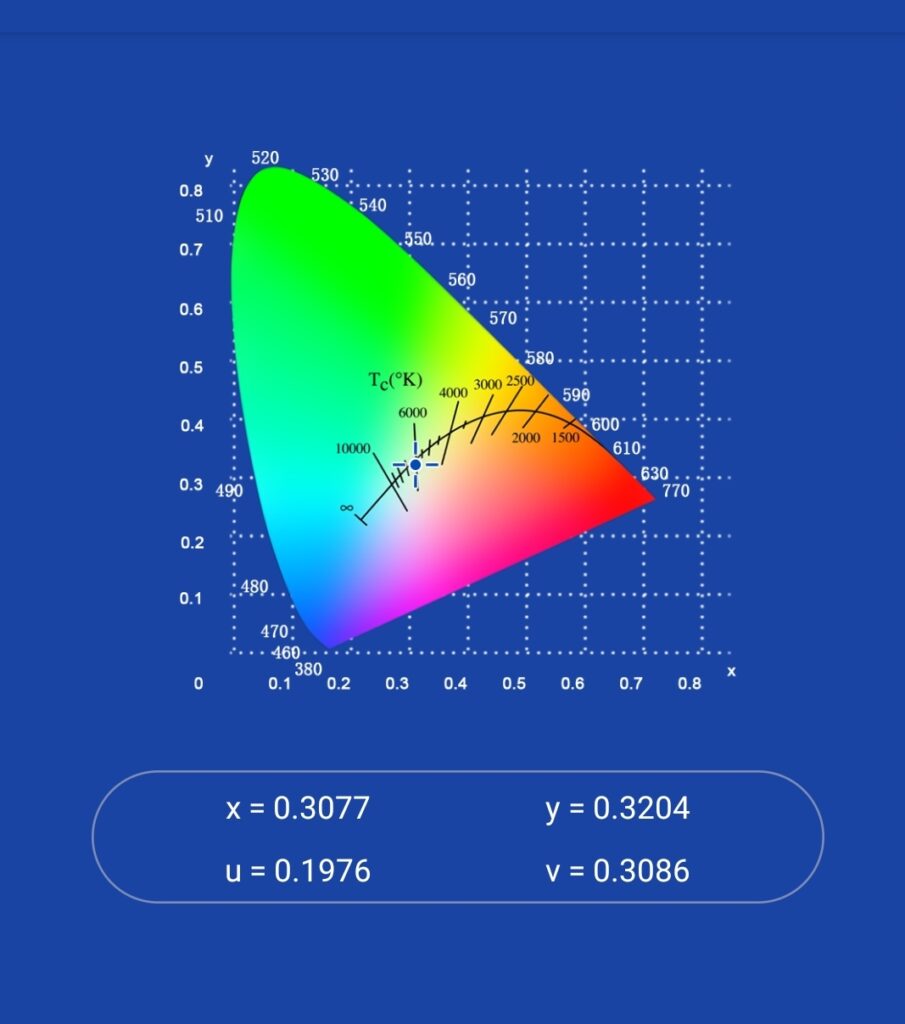
Dimensions and its competition
Dimensions:
| Cyansky P50R | Millimeters | Inches |
|---|---|---|
| Length | 140 mm | 5.5 in |
| Head diameter | 41 mm | 1.6 in |
| Body diameter | 25 mm | 0.98 in |
Dimensions are rounded to the nearest millimeter, and to the nearest tenth of an Inch.
Weight:
| Cyansky P50R | Weight in grams | Weight in oz |
|---|---|---|
| Without battery: | 160 g | 5.6 oz |
| With battery | 227 g | 8 oz |
Weight is rounded to the nearest gram, and to the nearest tenth of an Oz.
Flashlight size comparison with its competition:
Group 1 left to right: Cyansky P50R, Wurkkos TS25, Manker E14 IV, Mateminco LT40, Acebeam E75
Group 2 left to right: Cyansky P50R, WildTrail WT3M, Mateminco LT40, Fireflies E07 2021
Group 3 reflectors left to right: Cyansky P50R, Manker E14 IV, Mateminco LT40, Acebeam E75

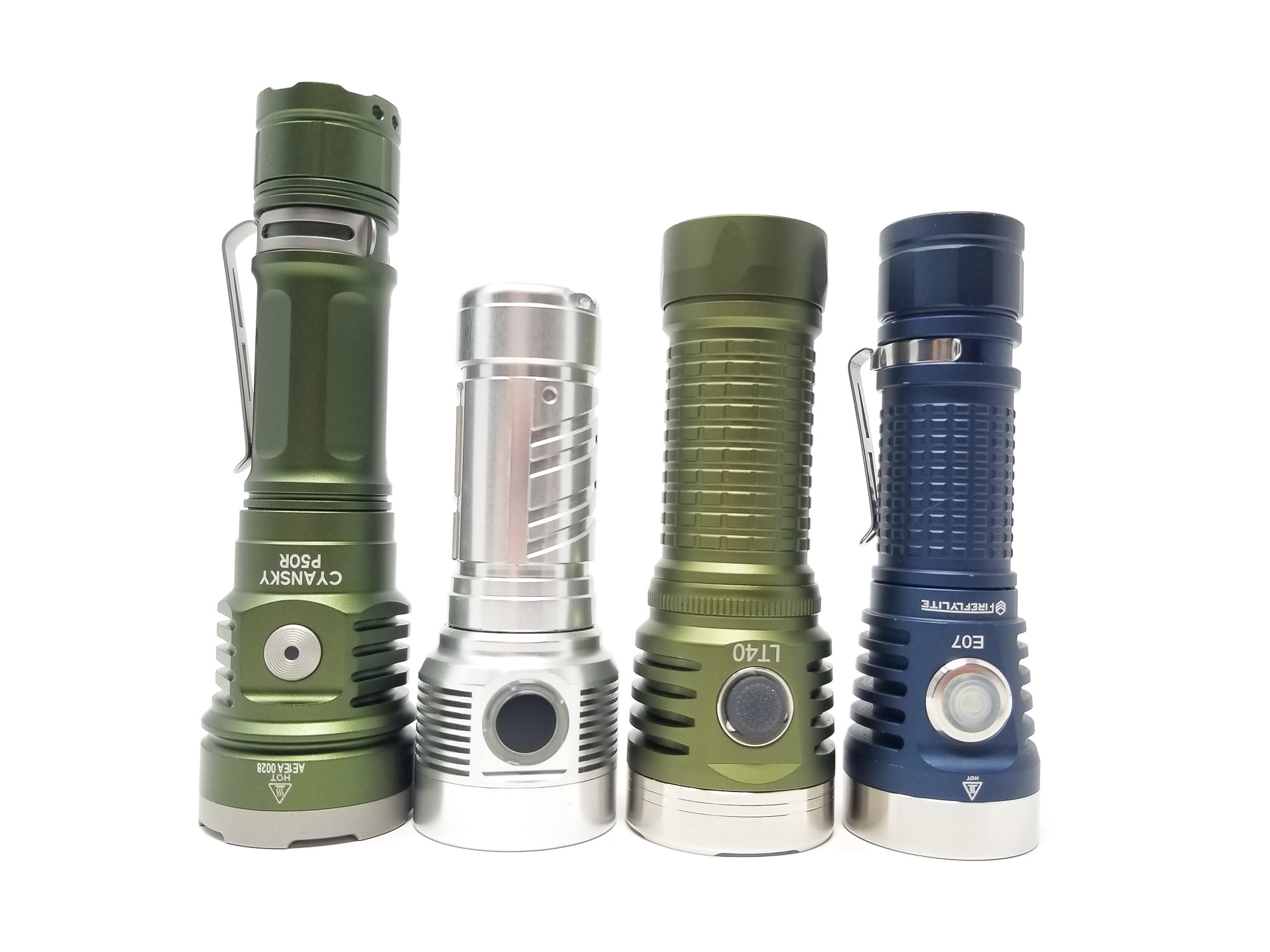
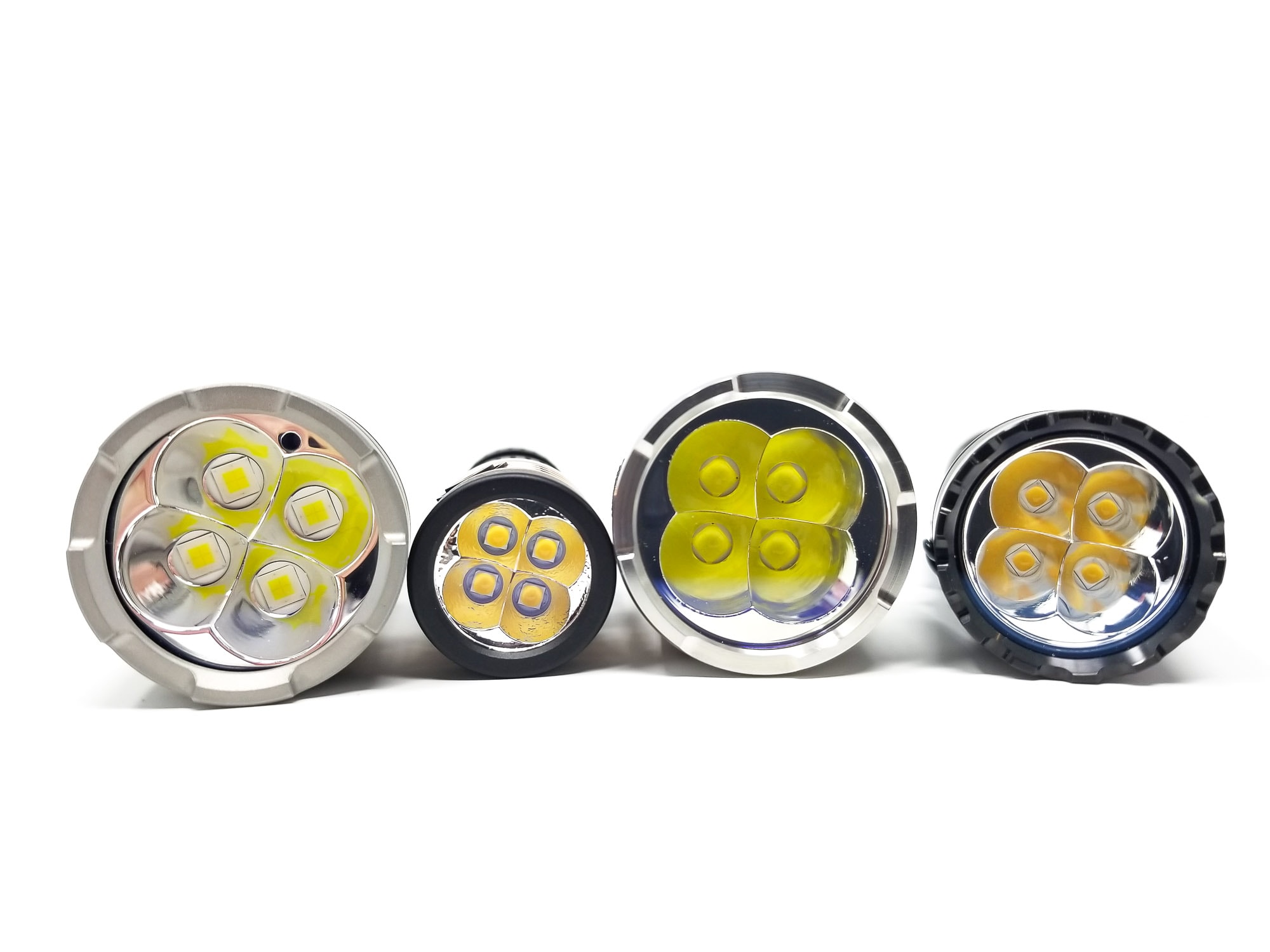
Cyansky P50R UI: User Interface and Driver
The driver is going to be a current regulated boost or buck driver with a direct-drive channel for Turbo. I’m thinking it might be a boost driver to keep the current managable. The UI is a very simple one as I expect from Cyansky and typical of this type of flashlight. It is a bit quirky though and had me scratching my head at times. It incorporates an auto-dimming proximity function to dim the output on higher modes.
*UPDATE 12/10/23: The replacement P50R Cyansky sent out has a completely different UI. They removed the High II mode, added an Eco mode, and changed the mode selection operation. There’s also changes for the auto dimmer, electronic lockout, and Strobe mode access. I’ve summarized the changes below for reference, but the revised UI table is available here: Cyansky P50R New UI
- Available modes: Eco, Low, Medium, High, Turbo
- Available blinky modes: Strobe
- Long press from OFF: Eco mode
- Press and hold from ON: Cycles through Low, Medium, High modes
- Double click from ON/OFF:Turbo
- Triple click from ON/OFF: Strobe
- Long press from ON in ECO: Cycles through L-M-H
- Mode memory: Yes. Aside from Turbo and Strobe all modes, including Eco are memorized
- Electronic lockout: Yes, 4 clicks from off enables lockout. The light blinks 3 times in Low and the switch LED turns on. If the switch is clicked, the light blinks twice in Low. To disable, repeat the lock procedure.
- Disable auto dimmer: The auto dimming disable procedure is now 4 clicks from on (it’s still re-enabled when the light turns off-although it wasn’t completely consistent in operation)
*The original review light UI*
Available modes:
- Low, Medium, High, High II, Turbo
Available blinky modes:
- Strobe
From OFF:
- Press and hold: Turns on in last used mode (see note on mode memory)
- Single click: Battery check (the LED indicator lights up for about 5 seconds red or green to show battery state)
- Double click: Lockout mode
From ON:
- Press and hold for 1 second: Turns off
- Press and hold for +2 seconds: Strobe
- 1 click: Advances modes L-M-H-H2-T-L
- Double click: N/A
- 3 fast clicks: Enables/disables the light sensor
- 4 fast clicks: The light blinks 3 times, but doesn’t do anything?
Mode memory:
- Last mode memory for Low and Medium only! High, High II, and Turbo are not memorized
Shortcuts:
- To Strobe: Press and hold from on or off for +2 seconds
Low voltage warning/protection:
- The switch LED shows battery state during operation and when pressed from off (displays for about 5 seconds): Solid green 75% to 100%, blinking green 50% to 75%, solid red 25% to 50%, blinking red 0% to 25%. The light also has visual LVP during operation. When the output drops to Low when the battery reaches 3 volts, the light will blink 3 times every 3 minutes. Cyansky states the LVP is set to turn the light off at 2.7 volts.
Strobe/blinkies
- Variable frequency strobe
Lock-out mode:
- Electronic lockout. Accessed from off with two clicks. The light blinks 3 times on Low to indicate the lockout. To unlock, double click again and the light unlocks to Low mode. The light will also unlock if the charging cable is plugged in.
PWM
- None visible
Additional/summary info on the UI:
- UPDATE 12/10/2023: I like this revised UI quite a bit more than the original. They fixed the original’s weirdness and it’s more or less a UI I expect to see from a company in this market position. Here’s what I like:
- Added a ‘lower’ Eco mode
- The mode spacing is much better
- Mode memory for all regular modes
- Fewer modes
- No press and hold for on/off
- Turbo is not part of the regular mode group
- 2 clicks for Turbo, 3 click for Strobe
- Electronic lockout is 4 clicks from off
- This is a pretty straightforward UI, with good mode spacing, but it is a bit quirky. Low and Medium are the only modes memorized, which is a bummer since it would have been nice to have High mode on memory. The proximity sensor is also a bit quirky. It’s supposed to be enabled by default and Cyansky says the sensor kicks the output down to 200 Lumens (Medium mode) if within 20 cm of an object. However, it seems to kick down when the bezel was about 3 inches from an object. Moving away will resume the previous brightness setting. The sensor can (thankfully) be deactivated from on with a triple click. Repeat to reactivate. The sensor will always default to on when the light is switched off and back on. Cyansky says there’s temperature regulation built-in. Turbo will step down after 15 seconds to 6000 Lumens, then 30 seconds to 3000, then another 30 seconds to 1500 Lumens before ATR starts.
Cyansky P50R Charging and batteries
Unlike others in this class, the light is only compatible with button top batteries, and Cyansky includes their high current BL2140P 4000 mAh branded cell. I tried a Samsung 50G button top, and some solder blobbed Samsung 40Ts and they worked fine. The standard, unprotected cells were a bit loose, but still worked.
This light is battery-picky, and I recommend using unprotected button top cells with this light to get the most out of it, as protected cells, even the most robust ones, will have the protection circuits tripped on Turbo and performance will be limited. Onboard USB type C charging comes standard on the P50R, like most all mainstream flashlights these days. It’s set for 5 volts 2 amps, and I was seeing about 5 volts 1.8 amps for about 9 watts. Both standard A to C and C to C cables worked fine. The fully charged battery read 4.18 volts.
| Charge type | Fits | No fit | Charge time |
|---|---|---|---|
| Flashlight with onboard USB-C | Standard, protected button top 21700s only | Flat top cells | About 2 hours |
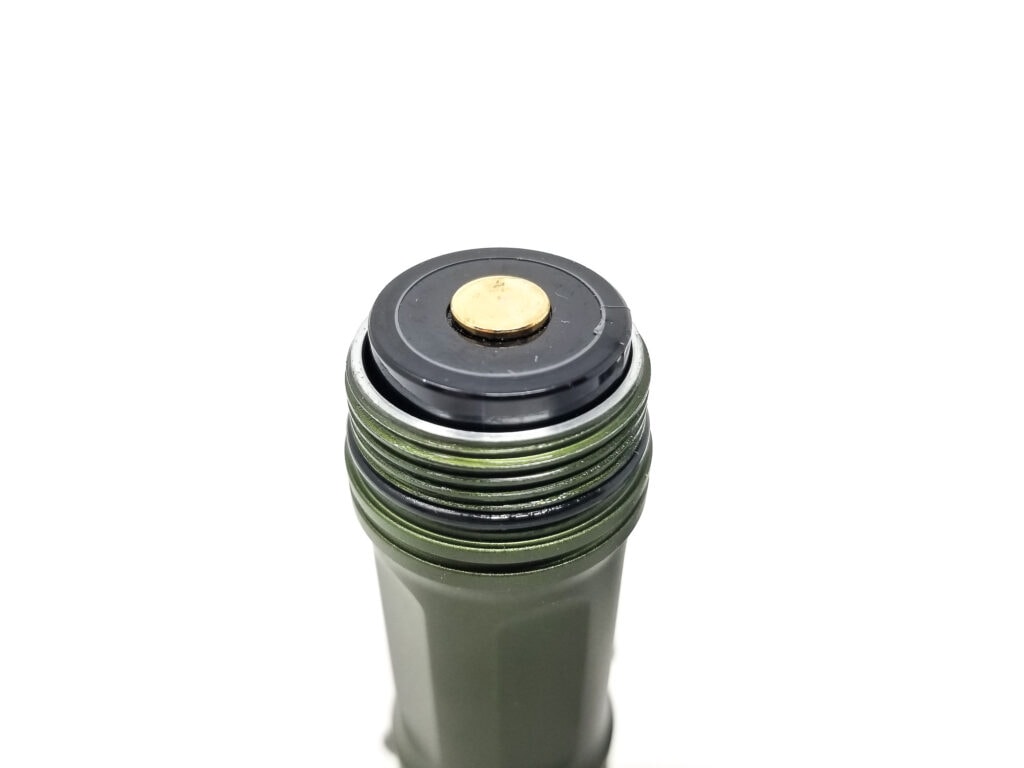
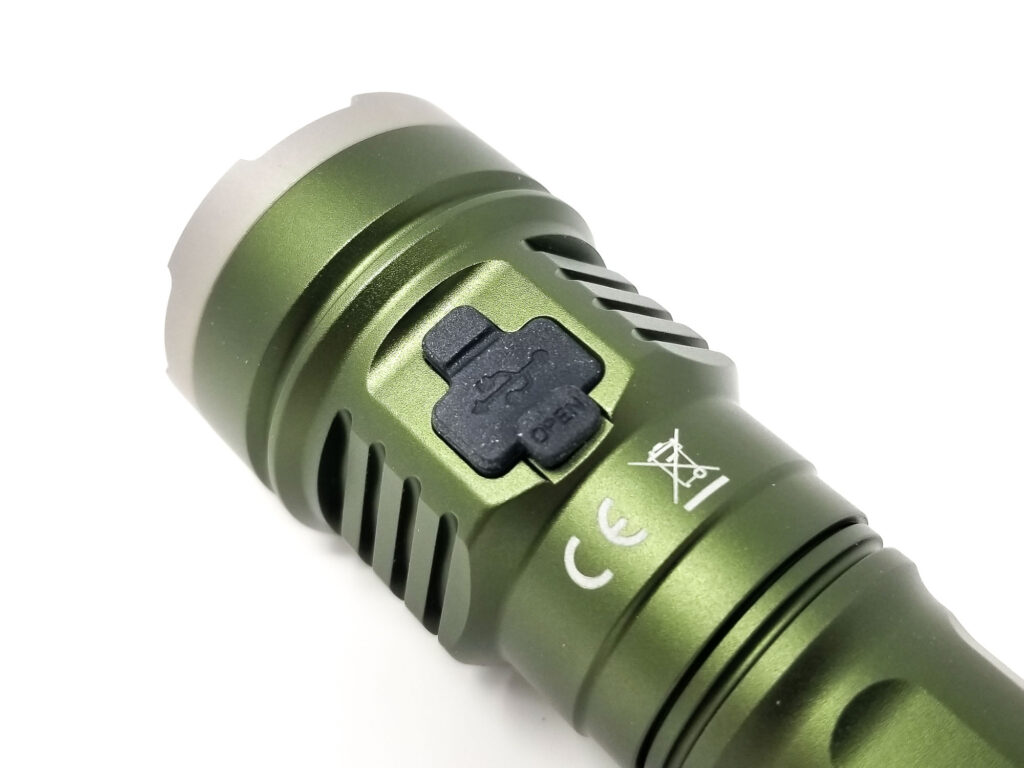
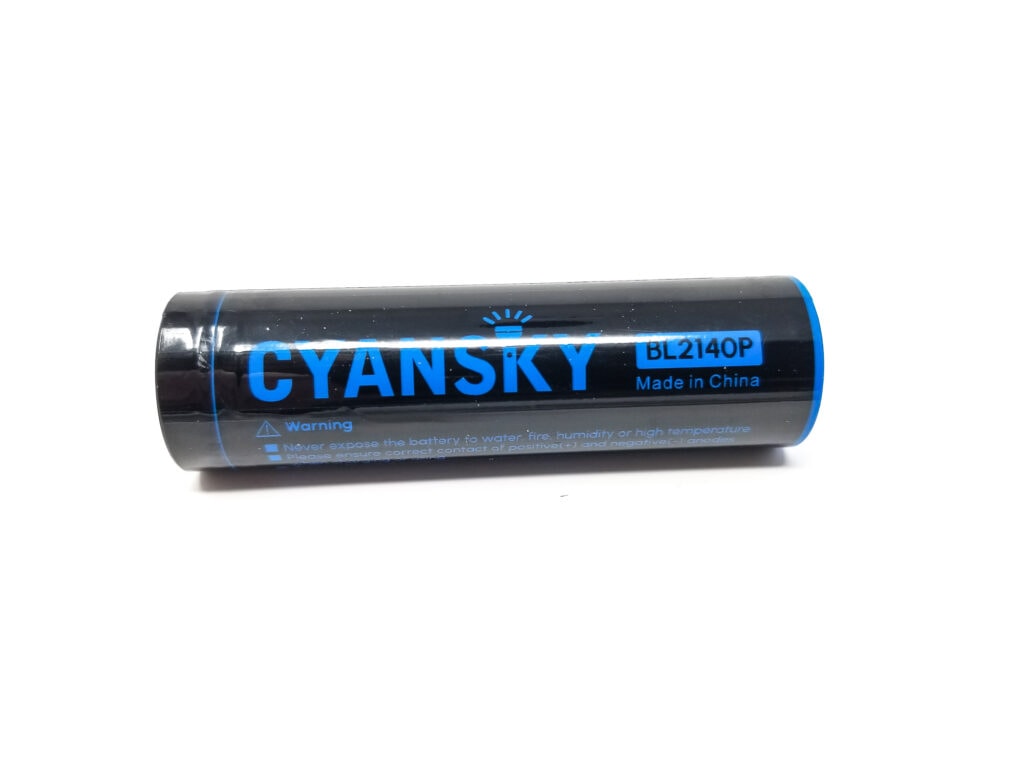
Performance test
Lumen measurements
How Lumens are Measured: Understanding ANSI FL1 Standards How Lumens are Measured: Understanding ANSI FL1 Standards: The ANSI FL1 standards specify that output in lumens should be measured 30 seconds after turning on, as this is the standardized time for measuring brightness according to the industry standard. This is why we focus on this part in our measurements. The ANSI FL1 standards require an ambient temperature of 22 ± 3°C. We record the ambient the ambient temperature to identify potential reasons for any observed discrepancies.Lumens are measured in my 30 cm integrating sphere with a Digi-Sense 20250-00 data logging luxmeter. The sphere has been calibrated with a Convoy S2+ measured to 260 Lumens and the figures are within 10% of actual. I used the fully charged included battery for the test. No current measurements this time due to the inaccessible current path.
| Mode | Specs | turn on | 30 sec | 10 minutes |
|---|---|---|---|---|
| Low | 50 | 49 | 49 | – |
| Med | 200 | 378 | 378 | 369 |
| High | 800 | 1284 | 1267 | 1161 |
| High II | 2000 | 3784 | 3696 | 1056 |
| Turbo | 12,000 | *7040 | 5896 | 1144 |
| Turbo retest Cyansky BL2140P | 12,000 | 10,980 | 4770 | 1710 |
| Turbo retest 21700XP cell | ? | 11,880 | 4860 | 1710 |
Parasitic drain:
- N/A couldn’t measure
*UPDATE 12/10/2023: Cyansky sent out another P50R sample with some updates (received December 8, 2023) to the UI and other tweaks and fixes. I retested Turbo mode since it was the most wonky from the first light with two different batteries, the included Cyansky BL2140P and the ultra-spicy mystery 21700XP cell included with the Nightwatch NS14R. The latter battery was to eliminate any variables caused by a weak or inadequate battery (other reviewers reported issues with the stock cell). No changes to the testing procedure. I had issues with the Cyansky battery the first time I ran Turbo, but the second retest netted positive results more in line with advertised. I still experienced the output ramp up from start to max brightness still took about 2 seconds, and it was quickly stepping down by 5 seconds when the datapoint was recorded. Peak brightness was just short of 12,000 Lumens at start, with the output reducing to 5000 Lumens by 30 seconds, then down from there settling about 2000 Lumens by 1 minute all the way until shut down. Switching to the ultra-spicy Nightwatch 21700XP cell netted appreciable gains in brightness, coming in well over 12,000 Lumens at start.
Maximum brightness for Turbo didn’t happen until the 5 second mark or so. The actual turn on reading was only 4136 Lumens. Turbo is coming in low with the other modes coming in high, and the measured output didn’t match the advertised figures. I double-checked my calibration and used two integrating devices to validate the results, and they were consistent. Maybe my sample is defective? Other reviewers of this light reported ‘anomalies’ with Turbo as well.
Cyansky P50R Battery Life: Runtime graphs
How Runtimes are Measured: Understanding ANSI FL1 Standards About ANSI FL1 runtime standards: The runtime is measured until the light drops to 10% of its initial output (30 seconds after turning on). This does not mean that the flashlight is not usable anymore. The last column shows how long the light actually works till it shuts off. If there is a + symbol, it means that the test was stopped at that particular point, but the light was actually still running. This happens on certain occasions, with certain drivers, firmware, or batteries.Runtimes are measured in my 30 cm integrating sphere with a Digi-Sense 20250-00 data logging luxmeter. The sphere has been calibrated with a Convoy S2+ measured to 260 Lumens and the figures are within 10% of actual. I measure temperature readings with a Digi-Sense 20250-92 data logging thermocouple. The thermocouple probe is affixed to the head with kapton tape, and I used the same 5 second sampling rate as the luxmeter. I used the included battery for the test. I recorded the temperatures for High, High II, and Turbo.
| Mode | Specified runtime | Measured runtime ANSI | Time till shut off |
|---|---|---|---|
| Med | 10h 30m | *8h 46m | 8h 46m |
| High | 3h | *2h 33m | 4h 40m |
| High II | 2h | *3h 48m | 3h 48m |
| Turbo | 1h | *1h 35m | 1h 35m |
| Turbo retest Cyansky BL2140P | 1h | 1h 5m | 1h 5m |
*ANSI figures are based on the actual measured performance figures!
Retest update 12/10/2023: I retested Turbo mode with the replacement unit Cyansky sent out since it was supposed to address the issues I experienced with the original test piece. So, how’d it do? The replacement performs quite a bit differently than the first sample, with performance much more consistent and more in line with the advertised specs. The Turbo turn-on figures were much better this go-around. I had some issues with the included Cyansky cell with Turbo.
Basically it had to be fully topped off or it wouldn’t even activate Turbo, but when it did work, with the stock Cyansky BL2140P cell, I got just short of 12,000 Lumens after a quick ramp up in brightness (briefly) then ramping down over 5 seconds to about 6,000 Lumens, before slowly stepping down again and stabilizing at around 2000 Lumens before shut down.
I also tested the Nightwatch 21700XP cell and got a bit over 12,000 at start (after the ramp up), with appreciable improvements in output until the regulated output stabilized. While the step downs are much quicker on the the replacement light (reportedly a fix by Cyansky to prevent the protection circuit in the included cell from being tripped and cutting the output like some early reviewers experienced), overall, this is much improved performance from the replacement light, and I hope this is the one Cyansky starts (or has been) selling.
I don’t like the quick step down, but workarounds are more cost-effective than redesigns and credits. Temperatures were recorded for the Nightwatch cell only since I didn’t record the BL2140P runtime temperatures. The temperatures look good also, never cresting 70 C, but the light isn’t hand-friendly after about 5 minutes when the tube hits 60 C. Overall, a much improved showing and way better performance across the board for the replacement.
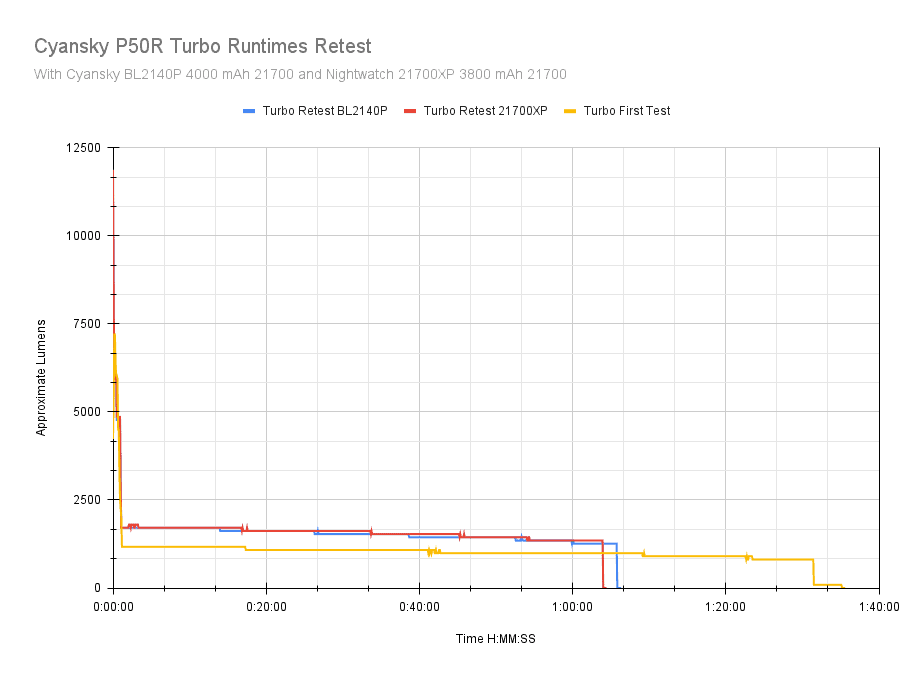
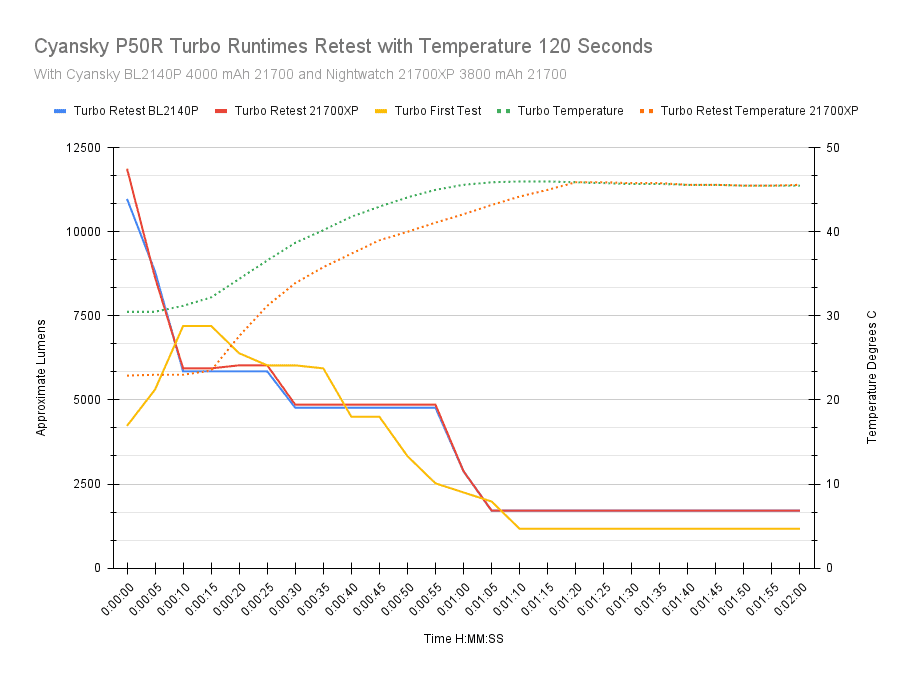

A few things. The driver is a fully regulated unit, with a direct-drive FET for Turbo. The outputs are nice and flat, and regulated for as long as the battery can supply 5 volts to the MCU before dropping to LVP. No issues there. The ATR works great, with no zigagging output throttling, and it kept the light around 50-52 C for High II and Turbo. However, here’s where it got a little wonky and a bit disappointing.
Using the stock cell, I got nowhere near 12,000 Lumens, and there was an odd brightness ramp-up from start, starting at 4136 Lumens and rising to 7040 after about 5 seconds. Hmmmm. I actually ran the Turbo test a second time to capture the full start up and step down to verify my results and it was pretty much identical. The proximity sensor was disabled before the test, and it didn’t appear it was interfering with the testing. The runtimes are somewhat consistent, although the brightness figures didn’t match so I based the ANSI reading on the measured outputs.
Here are the original runtimes, of the first version I received.

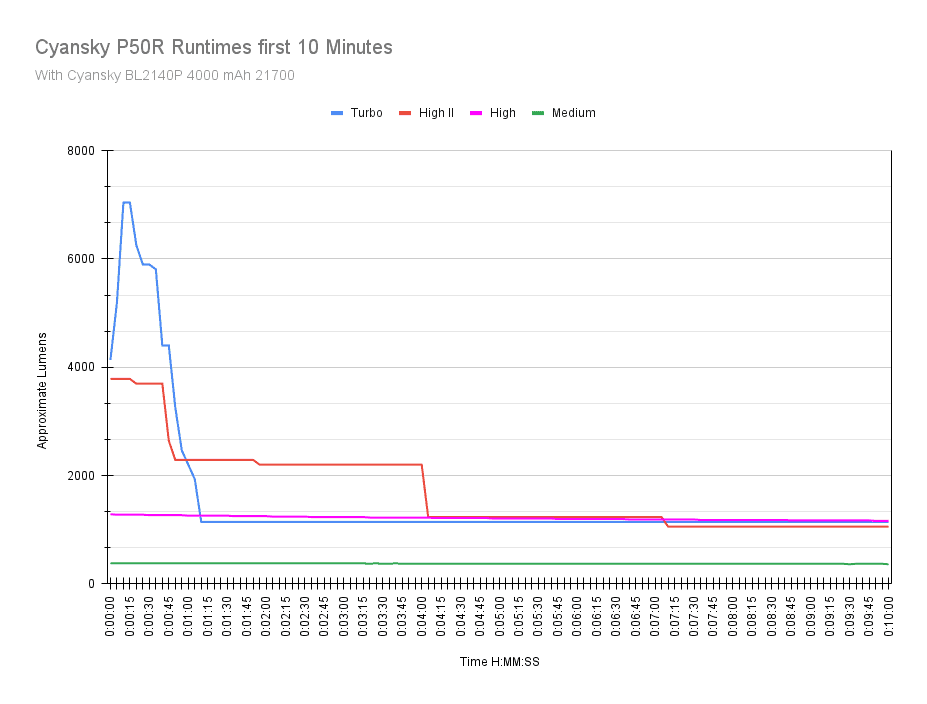
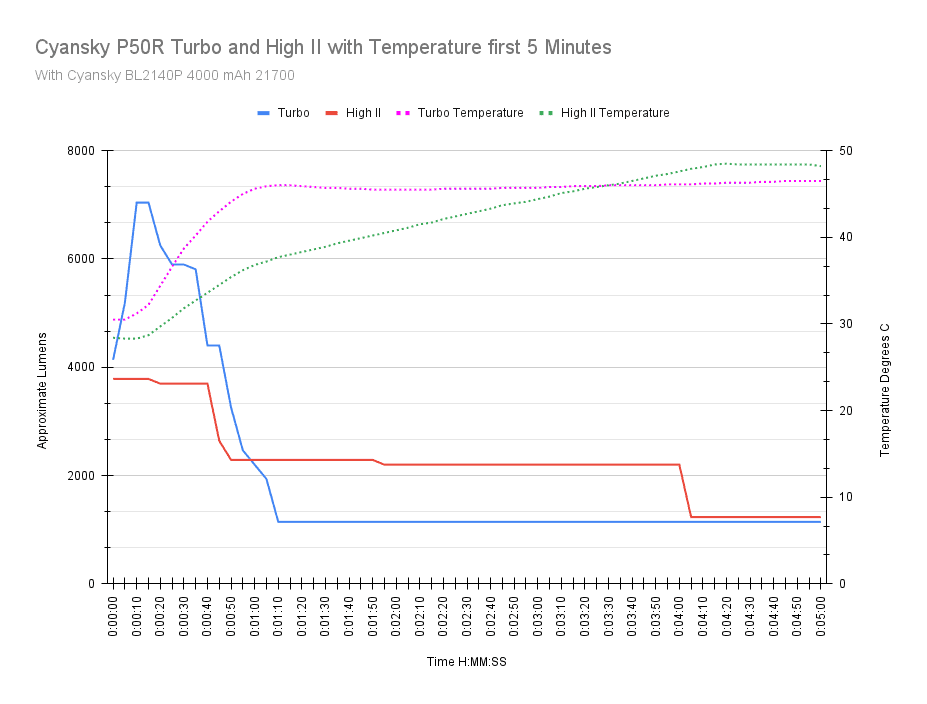
I ran some other quad and multiple LED lights against the P50R, and with similar batteries on board, all performed better, including the nearly $100 cheaper Astrolux FT02S, Mateminco LT40, and even the triple LED Imalent R30C (I retested Turbo and got much higher output). The unregulated FET drivers and Anduril UI of the Astrolux and Mateminco really hurt the sustained output, but for the price, you get a lot more performance. While it’s not really an apples to apples comparison, for demonstration purposes, I did a comparison of the Amutorch XT45 NB90.15 which is a single LED pocket light that beats the P50R on initial output and matches the sustained output, for more than half the price.
To rule out a weak cell, I ran some other, high performance 21700s in the light on Turbo. The results (at turn-on):
- Nightwatch 21700XP: 8800
- Nightwatch LR2170HP: 8624
- Samsung 30T: 8360
- Samsung 40T: 7304
- Molicel P42A: 7832
A bit closer to the advertised, but still a ways off. I experienced the same ramp-up with these batteries also. It appears my sample is under performing quite a bit on Turbo.

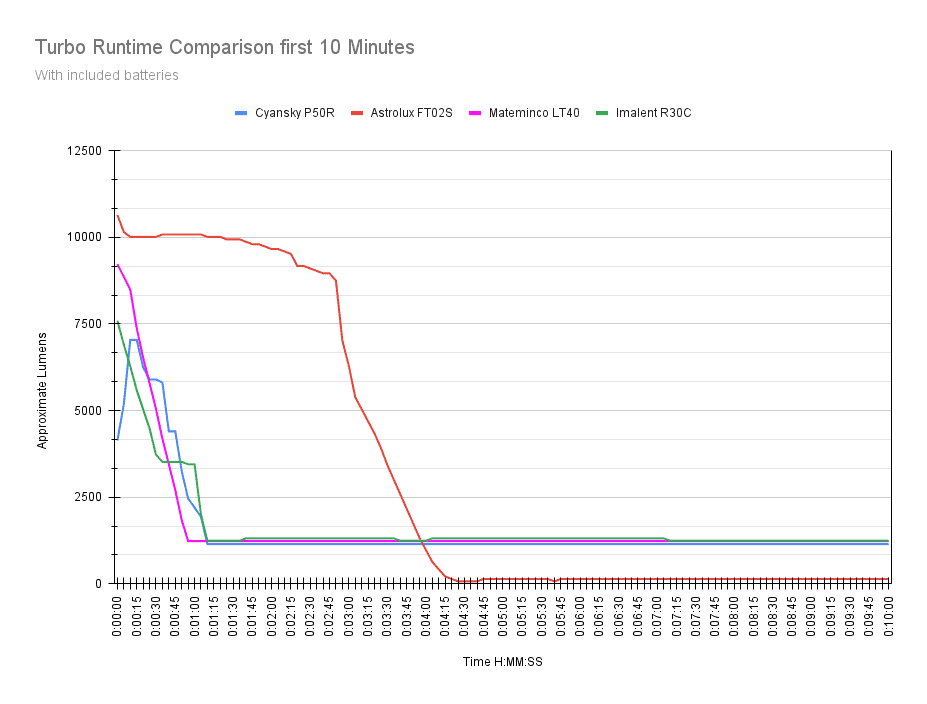
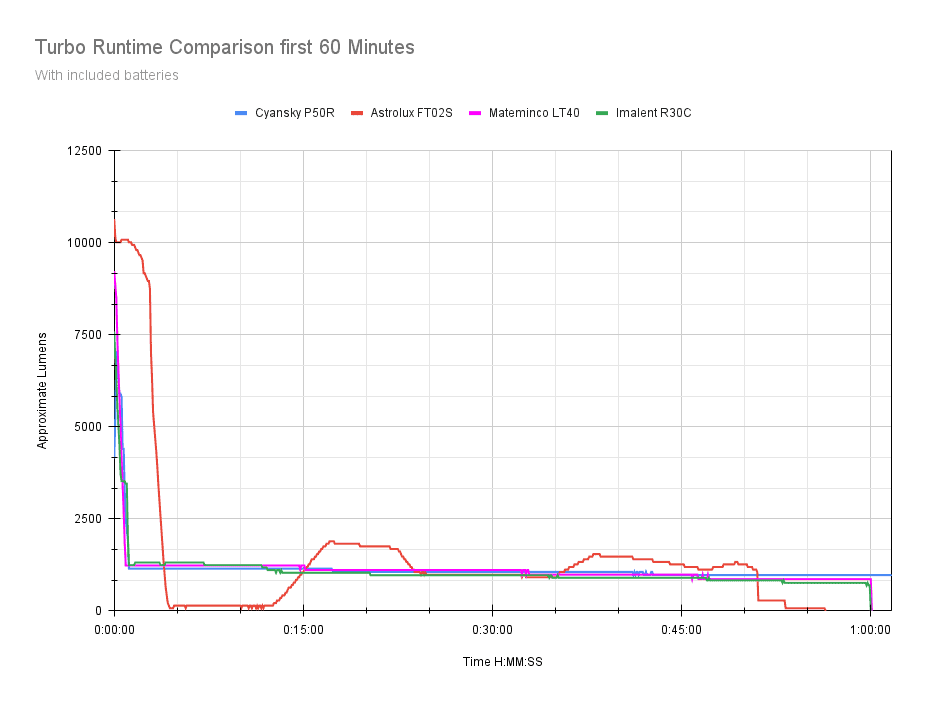
Peak beam intensity and beam distance measurements
About Peak beam intensity: Understanding ANSI FL1 Standards About peak beam intensity The calculated value of distance in meters at which the flashlight produces a light intensity of 0.25 lux. (0.25 lux is about the brightness of a full moon shining on an object). This means that the intensity has decreased so much, it becomes difficult to see darker objects, or objects that don’t reflect light. The columns ‘Meters’ and ‘Yards’ use rounded numbers.The beam distance test was conducted using the Uni-t UT383S luxmeter at a distance of 5 meters. I used the included battery for the test. Measurements taken at 30 seconds per ANSI spec.
| Mode | Specs | Candela measured | Meters | Yards |
|---|---|---|---|---|
| Low | 42.5 | 550 | 47 | 51 |
| Medium | 676 | 1550 | 79 | 86 |
| High | 2256 | 5100 | 143 | 156 |
| High II | 5625 | 16,075 | 254 | 278 |
| Turbo | 26,896 | 24,925 | 316 | 346 |
| Turbo at start | ? | 28,975 | 340 | 372 |
I’m not sure where the Low or the High II figure came from, but the rest look good. This isn’t a long-distance light, but this is respectable beam distance and plenty of reach.
Beamshots
Camera settings and distance: Photos taken with my Samsung Note 8 set to 0.3s ISO 200 and 5000K WB. The fence is 40 meters distant.
Beamshots of the following flashlights compared:
- Cyansky P50R
- Mateminco LT40
- Acebeam E75
- Manker E14 IV
- Astrolux MF01 Mini
- Fireflies E07 2021
- Astrolux FT02S
- Astrolux EC03
- Imalent R30C
- Amutorch XT45 NB90.16 (single LED flashlight)
Please note that beamshots are mainly intended to showcase the beam pattern and beam quality, rather than overall performance. These images are typically taken directly after activation, and do not fully represent its overall performance. For accurate performance metrics, such as output, beam distance, and runtimes, you need to look at the performance section of this review.










Disclaimer: This flashlight was sent to us for review at no cost by Cyansky. We have not been paid to review, nor have we been holding back on problems or defects.
Final Verdict
Pros
- Fully regulated output
- Great build quality, fit, and finish
- Very nice handling
- Compact host
- Versatile beam with great reach
Cons
- Expensive compared to competitors
- No spring for the driver contact
- MUCH quicker step downs for Turbo vs the original
Explanation on star ratings:
1: Avoid: a match would be a better choice – 2: Poor: significant defect or issues; almost unusable – 3: Average: some defects or issues; but still usable 4: Good: recommended (minor issues) – 5: Great: highly recommended

3.5 stars: ★★★⋆
While our star rating provides a reliable indicator, we encourage you to read the full review to make an informed decision based on your own needs and preferences.
UPDATE 12/10/2023: The replacement flashlight works great and rectifies the issues with the first test sample. The updated UI is ‘more normal’ and functional to boot, and I just like using the flashlight more. The performance is also nicely improved, with it hitting the output specs, and despite the much quicker step downs from Turbo, for the size, the sustained output is impressive, besting the larger Astrolux FT02S and other quad LED flashlights.
I wish Cyansky invested in a better battery for the P50R (or just use your own u protected high drain cell) like Imalent includes on their high output MS03 and R30C. It would help eke out a bit longer Turbo burn, but as-is, it’s not terrible. I’ll give it an extra ½ star for the improvements to the UI and the performance, so a solid 4 stars for the new-ish P50R. It’s still a tough sell in this segment, but if you’ve got the funds, and Cynaksy can guarantee you’ll get the new version without the wonky UI, give the P50R a look.
That’s a wrap! The first high output flashlight from the scrappy, underdog brand Cyansky turned out to be a mixed bag. There’s several bright spots, namely the superb build quality, regulated and consistent output, great handling manners, and versatile beam. Overall, it’s a nice package. However, it’s not all sunshine and rainbows. My sample had some output anomalies, and an unrefined UI with mode memory for only two modes.
The output for Turbo was way down, and the other modes were overachievers. Plus, while I get that it’s a high quality, high output light, Lumens are cheap these days, and there are cheaper, but similarly high output options (albeit with some cost-cutting compromises). For example, the $65 Amutorch XT45 NB90.16 is a single LED light, which matches and beats the P50R. The Acebeam E75, while it can’t match the initial Turbo output, it does match the other modes, with a gorgeous tint and great beam, for about $99.
My verdict? Unless you have the disposable income and are a die-hard Cyansky fan, it’s hard for me to recommend the P50R over some cheaper competitors. Don’t misread me here because I think the P50R’s superb build quality, great handling and versatility can make up for the performance anomalies. With some refinement and tweaking (which if I know Cyansky, they’re probably already working behind the scenes on a P50R V2 perhaps?), this would be a fantastic high output quad that can trade blows with the best of the best in this category. For now though, 3.5 stars for the P50R.
Buy your Cyansky P50R here:
1lumen selects and reviews products personally. We may earn affiliate commissions through our links, which help support our testing.